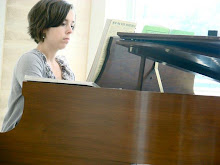At times yes, but not always. Some famous variation form pieces: Goldberg Variations. Cop out? Certainly not. Diabelli Variations? Also a no. Mendelssohn's Variations Serieuses? Not a cop out. Clara Schumann's Variations on a Theme by Robert Schumann? Perhaps. Is it true that a composer writes in variation form when he/she has no inspiration to come up with a better idea? In most instances I would guess no because there are plenty of respectable variation pieces out there.
Mendelssohn in his Variations Serieuses comes closer to the great and famous Goldberg and Diabelli than does Clara Schumann in her Variations on a Theme by Robert Schumann. Thinking back to our studies of the Diabellis last semester, Beethoven achieves an elevated state of the theme through altering texture, tempo, character, etc. (In this case he actually took something trivial and made it better). After a certain point, the theme was barely even recognizable anymore. Mendelssohn, like Beethoven, also used a fugue in his variations. (Interesting, eh? since this piece was written for the Beethoven Monument in Bonn). Neither Mendelssohn's fugue nor his trajectory throughout the piece is quite that of Beethoven, but I still find a lot of merit in his work. Throughout the piece the theme is preserved and can always be perceived, yet through changes in setting, character, texture, and sometimes harmony, it does not get old. Mendelssohn remains rather conservative in the beginning, but by the 3rd variation (staccato chords and octaves) the original idea is almost completely changed. It is the harmony and contour of this variation that recall the theme. I appreciate that Mendelssohn is able to take us to a different place in each variation. One of my favorites is variation 13. The theme is blatantly obvious at this point, but I find it to be a refreshing return after exploring all of the different ideas that were just presented to us. Mendelssohn makes the variations his own. Don't you think that variation 11 sounds like a song without words?
While I respect and enjoy Clara Schumann's variations, they do not hold my interest to the same degree. She is not as experimental as Mendelssohn is, and she does not venture too far from the theme. It is always heard with relative clarity throughout the variations, and she even returns to the original idea of the theme a couple of times (variations 3 and 6 lie in the same vein - homophonic, more static than the others). There are some exciting moments of virtuosity though. Variations 2, 4, 5, and 7 illustrate the Bravura technique that I mentioned in my presentation. I can imagine that Clara wrote such variations for her own enjoyment while performing.
Mendelssohn in his Variations Serieuses comes closer to the great and famous Goldberg and Diabelli than does Clara Schumann in her Variations on a Theme by Robert Schumann. Thinking back to our studies of the Diabellis last semester, Beethoven achieves an elevated state of the theme through altering texture, tempo, character, etc. (In this case he actually took something trivial and made it better). After a certain point, the theme was barely even recognizable anymore. Mendelssohn, like Beethoven, also used a fugue in his variations. (Interesting, eh? since this piece was written for the Beethoven Monument in Bonn). Neither Mendelssohn's fugue nor his trajectory throughout the piece is quite that of Beethoven, but I still find a lot of merit in his work. Throughout the piece the theme is preserved and can always be perceived, yet through changes in setting, character, texture, and sometimes harmony, it does not get old. Mendelssohn remains rather conservative in the beginning, but by the 3rd variation (staccato chords and octaves) the original idea is almost completely changed. It is the harmony and contour of this variation that recall the theme. I appreciate that Mendelssohn is able to take us to a different place in each variation. One of my favorites is variation 13. The theme is blatantly obvious at this point, but I find it to be a refreshing return after exploring all of the different ideas that were just presented to us. Mendelssohn makes the variations his own. Don't you think that variation 11 sounds like a song without words?
While I respect and enjoy Clara Schumann's variations, they do not hold my interest to the same degree. She is not as experimental as Mendelssohn is, and she does not venture too far from the theme. It is always heard with relative clarity throughout the variations, and she even returns to the original idea of the theme a couple of times (variations 3 and 6 lie in the same vein - homophonic, more static than the others). There are some exciting moments of virtuosity though. Variations 2, 4, 5, and 7 illustrate the Bravura technique that I mentioned in my presentation. I can imagine that Clara wrote such variations for her own enjoyment while performing.
